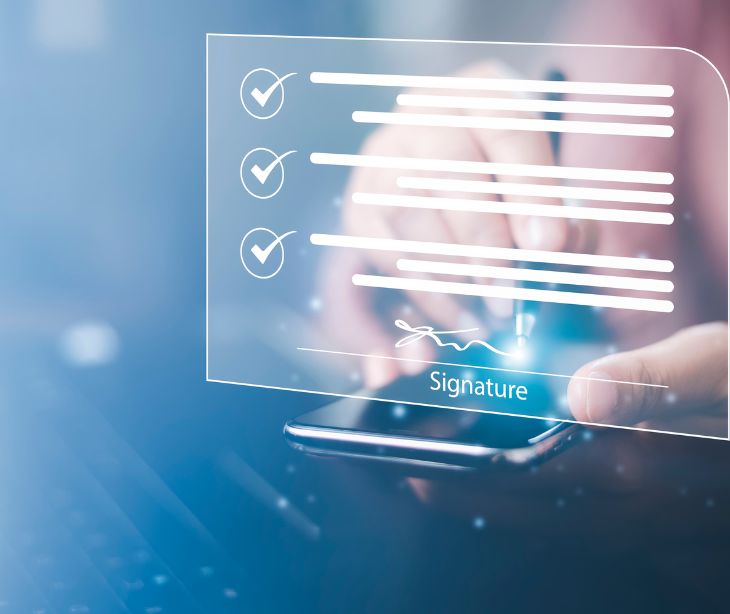
An electronic signature is a broad term encompassing any electronic process indicating a person's agreement to the terms of a document. A digital signature, however, is a specific type of e-signature that uses additional security techniques to securely attach the signer’s identity to a document and ensure its integrity.
Electronic signatures
An electronic signature, often known as an e-signature, is a digital form of signing documents electronically instead of using paper and pen. It works by allowing individuals to use various methods, such as typing a name into a digital document, using a finger or stylus on a touchscreen, or clicking an "I agree" button. These actions are legally recognized as a means to confirm identity and consent when they meet specific criteria.
The criteria
According to 21 CFR 11(c): “Before an organization establishes, assigns, certifies, or otherwise sanctions an individual's electronic signature, or any element of such electronic signature, the organization shall verify the identity of the individual.”
The U.S. Electronic Signatures in Global and National Commerce Act (ESIGN Act) outlines specific requirements that must be met for an electronic signature to be considered valid and legally binding. These requirements include:
- Intent to sign: Just like with traditional ink signatures, electronic signatures must be executed with the clear intent of the parties to sign the document.
- Consent to conduct transactions electronically: Both parties involved in the transaction must consent to do business electronically.
- Association of signature with the record: The electronic signature must be linked to, or logically associated with, the electronic record being signed.
- Record retention: Electronic signature systems must be able to accurately reproduce the signed record for later reference by all parties.
How to make it HIPAA compliant
Not all e-signature technologies are suitable for use in healthcare settings involving patient information.
These requirements include:
- An e-signature solution must ensure that data cannot be altered after applying the signature.
- There must be the ability to verify the identity of the signer.
- There should be detailed logs of all e-signature activity.
- Encryption should be present for the document transmissions and storage to protect against unauthorized access.
- The provider must provide a business associate agreement (BAA).
How it can be used alongside healthcare email
Using HIPAA compliant email is the best way to send an electronic signature in the healthcare sector because it makes sure that all data, specifically patient data remain protected. A few of the uses of e-signatures in a healthcare setting include
- Patient intake forms
- Informed consent
- Medical records
- Prescription orders
- Insurance claims and billing
- Referral letters
- Employee onboarding
See also: What is an e-signature?
Digital signature
Based on a 2018 journal study on the topic of the application of digital signatures, the following idea was introduced: “Just as the stamps, seal or signature play role in traditional system to create the authentication of paper document, the digital signature plays the role of authenticating the electronic record. It creates the authenticity of any electronic record which subscriber of digital signature wants to be authenticated the electronic record by affixing his digital signature.”
A digital signature is a type of electronic signature that uses cryptographic techniques to secure and verify the identity of the signer. Digital signatures are created using a mathematical algorithm that generates a unique data set or "signature" based on both the signed document and a private key known only to the signer. This makes it almost impossible for anyone to forge or tamper with the signature without detection.
The types
- Simple digital signatures: These include basic forms such as scanned images of a signature or a signature created on a touchpad. They are generally used for low-risk purposes.
- Standard digital signatures: Often referred to simply as digital signatures, these use a standard public key infrastructure (PKI) for creating and verifying signatures. They are more secure than simple digital signatures because they provide a means to verify the authenticity of the signer's identity.
- Advanced digital signatures (ADS): These signatures include all the features of standard digital signatures with additional attributes such as the ability to detect any subsequent changes after signing. They are linked uniquely to the signer and are capable of identifying them, ensuring high security and compliance with strict legal standards.
- Qualified digital signatures (QDS): A subclass of advanced digital signatures, these are created using a secure signature creation device and are based on a qualified certificate for digital signatures. QDS are recognized legally across various jurisdictions, offering the highest level of trust and security.
- Cryptographic digital signatures: These involve more complex cryptographic operations and are used primarily in sectors where high security is needed, such as government and banking. They ensure that the digital document remains unchanged from the time of signing and confirm the signer’s identity through secure means.
How to make it HIPAA compliant
- Advanced encryption: Make use of advanced encryption standards, such as AES (Advanced Encryption Standard) with a 256-bit key, for all digital signature processes. This secures the data during transmission and while at rest.
- Authentication mechanisms: Use strong authentication mechanisms like two-factor authentication, digital certificates, or biometric verification to confirm the identity of the signer.
- Tamper-evident technology: Employ digital signature solutions that include tamper-evident technology, which alerts users if a signed document has been altered after the signature was applied.
- Data integrity checks: Implement mechanisms to regularly check the integrity of stored data. This helps ensure that no unauthorized modifications are made to the documents or their signatures.
- Data resilience: Ensure that backup and recovery procedures are in place for electronic documents and signatures. This protects against data loss and ensures continuity of care in the event of an incident.
How it can be used alongside healthcare email
- Telehealth consent
- Medical orders
- Patient discharge instructions
- Clinical trial documentation
- Quality assurance documents
- Pharmacy orders and returns
- Equipment procurement
- Health Information Exchanges (HIE)
- Informed consent for data sharing
The difference between e-signatures and digital signatures
Based on a Forensic Sciences Research study: “Electronic signature is a broad term that includes: digital-based algorithm-derived signatures, biodynamic signatures produced on an electronic device which is a representation of an HS and electronically scanned versions of handwritten signatures (ESS)..”
While all digital signatures are e-signatures, not all e-signatures are digital signatures. E-signatures are a broad umbrella including any electronic means that indicates acceptance of an agreement or a document. They are primarily used to capture the intent to agree or approve the contents of a document and are recognized legally for their versatility and convenience in a wide array of transactions.
Digital signatures, a subset of e-signatures, provide a higher level of security and are built on cryptographic technologies. Digital signatures operate by creating a unique digital fingerprint of the document, which is linked through a secure process involving a set of cryptographic keys: one private (known only to the signer) and one public (available to anyone). This mechanism ensures that any changes made to the document after it is signed invalidate the signature.
The distinction between e-signatures and digital signatures lies in their use cases and the level of security they provide. Digital signatures are necessary for situations where legal authenticity and non-repudiation. In contrast, e-signatures are widely used for general approvals, and personal documents, where the main requirement is to demonstrate agreement rather than secure the contents fundamentally.
See also: What’s the difference between electronic and digital signatures in healthcare?
Which solution do Paubox forms use?
Paubox Forms uses electronic signatures (e-signatures) to facilitate the secure and compliant signing of healthcare documents. The platform provides two specific options for capturing e-signatures, which are clearly highlighted in its features: users can either draw their signature using a mouse, stylus, or touchscreen interface, or they can type their name in a designated signature field.
When a form containing a signature is transmitted via Paubox’s email suite, it is encrypted both in transit and at rest. This makes sure that unauthorized parties cannot access or alter the signature or other sensitive information. This encryption is a requirement under HIPAA’s Security Rule, which requires secure handling of electronic protected health information (ePHI) to prevent data breaches.
Choosing the right signing solution
Document sensitivity and security requirements
- Digital signatures should be used for medical documents that contain sensitive health information or are important to patient care and legal compliance. This includes patient consent forms for treatment, medical records, and prescriptions.
- E-signatures may be suitable for less sensitive healthcare documents unless used with HIPAA compliant features like Paubox Forms, which provide enough security for the form to be used for consent forms for treatment, medical records, and prescriptions.
User authentication needs
- Digital signatures provide secure user authentication that verifies the signer's identity through digital certificates issued by trusted Certificate Authorities (CAs). This level of authentication is necessary for signing high-stakes documents such as surgical consents or high-cost treatment agreements.
- E-signatures without HIPAA compliant services are adequate for healthcare scenarios where the identity verification can be more flexible, and where extensive verification is not mandated.
Technical and operational considerations
- Digital signatures may require the integration with existing healthcare IT infrastructure, which could increase the initial cost and complexity but provides long-term benefits in terms of security and compliance with health data laws.
- E-signatures provide a simpler and quicker implementation, beneficial for healthcare facilities that handle a high volume of routine documentation, enabling them to improve workflow efficiency without high IT overheads.
Cost implications
- Digital signatures might involve higher ongoing costs due to the need for digital certificates and potentially more complex infrastructure. However, the investment could be justified by the enhanced security and compliance with healthcare regulations.
- E-signatures are more cost-effective and are typically priced on a scalable model, suitable for healthcare organizations that need to manage large quantities of less sensitive documents.
International use and acceptance
- Digital signatures are preferred for international healthcare operations involving cross-border data transactions, as they are more likely to be recognized and accepted under international healthcare compliance standards.
- E-signatures may be suitable for use within specific countries or regions but require verification to comply with local and international regulations concerning health data.
See also: HIPAA Compliant Email: The Definitive Guide
FAQs
Can digital signatures be forged?
Digital signatures are more difficult to forge compared to e-signatures.Any tampering with the document after signing invalidates the signature.
Do e-signatures and digital signatures require special software?
Digital signatures often require specific software that adheres to international standards for cryptographic security (e.g., Public Key Infrastructure - PKI systems). E-signatures, however, can usually be executed with more general software solutions.
How do revocation of signatures work for e-signatures versus digital signatures?
Revoking a digital signature typically involves revoking the digital certificate that was used to create the signature, which is managed through a Certificate Authority (CA). For e-signatures, revocation isn't as straightforward since they do not rely on a digital certificate.
Subscribe to Paubox Weekly
Every Friday we'll bring you the most important news from Paubox. Our aim is to make you smarter, faster.




